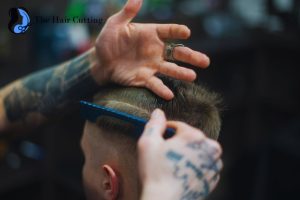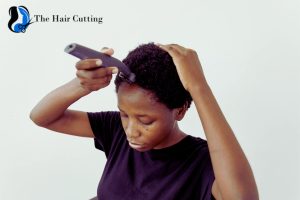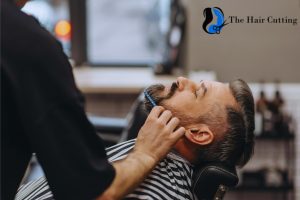Hair clippers
Hair clippers with a stationary comb-like blade provide one with a similar but mobile blade bound up in a holder and driven by a motor to reciprocate with an oscillating motion, as shown below. A torsion spring similar to the one shown here is hooked in recess on a mobile blade holder and serves the following purposes.

It has the pressing force on the mobile blade holder for it to provide a friction force necessary between both blades, either moving or fixed to result in the appropriate cutting of hairs. At the same time, it is also responsible for regulating the forward and backward translation of the blades such that there will always be the trimming of a hair length appropriately hair clippers. High-quality torsion springs with constant spring constants are of advantage for better precision. In an electric hair clipper, the motions of mechanical parts are due to electromagnetic effects.
A ferromagnetic material suspended in a spring, whose other end is fixed on the hair clipper cover is subjected to the electromagnetic force created by the field of an electromagnet. That electromagnetic pressure is a nonlinear characteristic of the present day flowing through the magnetic circuit. Accordingly, the induced motion of the ferromagnetic material is also nonlinear. The design of electromechanical systems can be quite challenging when nonlinear effects are taken into account, which strongly affect their dynamic behavior.
Therefore, it is really important to study the type of system in the context of laws and rules of widely quoted nonlinear phenomena, hair curler, electric shavers, shaving, nose trimmer, bikini trimmer which go with stability theories. These types of studies will make it possible to use new physical tools to understand the properties of clipper vibration. Such research might, therefore, point towards a better design of clippers in general and significantly improve the performance of the shaving industry. The evidence as to whether removal of hair can reduce the risk of infection remains unresolved. For several reasons, it is an interesting question.
Because hair grows from follicles beneath the surface of the epidermis, hair clippers becomes a tissue component colonized with microorganisms, as does the skin surface. Growth of body hair is known to be of intrapersonal as well as interpersonal variation, but in males, testosterone further contributes to increased growth of terminal hair in the face as well as the chest, back, legs, genitals, hair clippers. This distinction in hair boom may also explain why guys have a drastically better bacterial infection inside the surgical discipline and correspondingly an expanded threat of infections.
Previous investigations of shaving with a razor, using depilatory cream, or hair clippers on PJI demonstrated that clipping was the least aggressive method for skin preparation when shaving was done with a clipper. All studies evaluating the impact of clipping on the PJI infection have low quality since they have limited follow-up time, timing of clipping, type of clipping not reported, site of clipping unknown, and no control.
This is a randomized controlled study that explored the effect of hair clippers removal using a clipper on skin colonization and whether hair removal may induce a shift in the skin microbiota in male patients before knee arthroplasty. A non-blinded within-person randomized controlled study design was used, whereby the same patient served as their control for skin swabs taken from both intervention and control sites.

Colony-forming unit reduction at Days 0, 1, and 7 served as the primary outcome. Changes in the composition of the skin microbiota following hair removal with a clipper formed a secondary outcome. The sample collection, bacterial cultures, and CFU count were carried out by one investigator, while the bacterial identification was done by another investigator to ensure uniform collection and processing of samples.
Hairstyle trends for men have changed over the years from the big afro’s of the 1960s-70s to the blade-fade haircut or German cut that was popular in the 1920s, and 1990s and still is today to the current clean shave that started at the turn of the last century and is worn by 70% of black men in Cape Town Townships.
Originally, the blade-fade or German-cut was worn by working-class men in the 1920s and remained popular among Hitler’s Wehrmacht soldiers in Germany, hence the name. The clean-shave hair clippers is also worn by most black men in South Africa as well as the African diaspora. Apart from merely being a fashion statement, this checkup haircut forms part of some African tribal cultures.
The haircut is obtained by either a razor blade or by placing the metal of the electric clipper directly onto the scalp without using the manufacturer-supplied plastic combs. This produces a shave hair clippers that resembles the shave produced by a razor blade. Shaving papules more often seen on the beard also appear on the scalp as transient papules and pustules.
Haircut-related bleeding
On history taking, bleeding from the scalp due to the clean-shave hair clippers was identified incidentally from patients participating in a population study. A follow-up study of the determinants of FKN in men discovered that 32% of men with unknown HIV status reported that they had at least one episode of bleeding during a clean shave hair clippers. The authors then probed the potential healthcare risks of the clean shave haircut, and they found that 24.8% of HIV-positive men in their sample also reported a history of bleeding during a clean-shave haircut.
The clean-shave haircut was found to be an independent risk factor for scalp injury and hair clippers associated bleeding with or without the presence of FKN. Recently, invisible bleeding was detected from scalp swabs after professional clean-shave haircuts. A dermatologist examined the participant’s scalp and no scalp visible injury was noted. Scalp swabs were taken and tested for blood-specific RNA markers. 37% of participant’s scalp swabs were positive for HBB suggesting microscopic bleeding. The potential transmission of bloodborne viruses such as Hepatitis B and the Human Immunodeficiency Virus is most concerning.

Conclusion
Whether the various methods used in dehairing hair clippers and razor blades are virucidal and effective in disinfecting the instruments before using them on another client is not known. To address this issue, a cross-sectional study was carried out in Ethiopia to determine barber knowledge, attitudes, and practices about the sterilization of sharp equipment in their workplace and to evaluate the microbiological efficacy of sterilization methods.
They found heat as the preferred method for inactivating blood borne pathogens such as HIV. The use of open flames for sterilization has been well-reported in African countries, but there is no data on efficacy or adequate exposure time. The most common cleaning method used was the use of ethanol and sodium hypochlorate but the concentration, quantity, and duration of cleaning of equipment was variable. Commercial methylated spirit contains ethyl alcohol and methyl alcohol is most commonly used to decontaminate barber equipment.
Ethyl alcohol and methyl alcohol are not virucidal. Thus knowledge of the correct disinfectant and sterilization methods by barbers is important. The Ethiopian study found that participants had poor knowledge of sterilization procedures. They attributed this to the fact that informal barbers operate in unlicensed barbers and carry out grooming practices without knowing important health safety principles. Many developing countries lack regulating bodies that monitor the correct health practices at barbershops.

